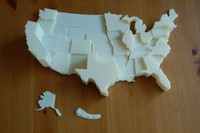 You have an accessible 3D printer nearby or you have an account at a 3D print service. Filled with the strong feeling that you can make anything, you then realize you must have a 3D model to print.
You have an accessible 3D printer nearby or you have an account at a 3D print service. Filled with the strong feeling that you can make anything, you then realize you must have a 3D model to print. That’s where the problem shows up: models are not always easy to acquire. But here are the ways you can get them:
- FROM A 3D PRINT SERVICE. Most of the popular 3D print services such as Shapeways, Sculpteo, Cubify, Ponoko or i.Materialise have a library of 3D models you can choose from. While the models likely aren’t exactly what you’re looking for, some do offer minor personalization opportunities.
- DESIGN IT YOURSELF. This is the most difficult option, as 3D design is a skill that most people don’t have. Skilled 3D design takes a great deal of time to acquire and the tools to do so are often quite expensive. However, if you do have the time to learn you can find some inexpensive or free 3D modeling software. Some are even available as web-based services. Best check out our resources page for a good list of options.
- FIND IT. You could browse through online 3D model repositories to eventually find what you want, but it may take some time as there are quite a few repositories open. Worse, most of the 3D model repos store models designed for visual rendering and not for 3D printing. There are few repositories dedicated to 3D printable models, but you could start with Thingiverse or Cubify.
- SCAN IT. You likely don’t have access to a USD$60,000 3D hand scanner, but you probably do have a digital camera. With a common camera it is possible to take still images of an object from multiple angles and upload them to conversion services. These services analyze your images and do their best to extrapolate a 3D model of your subject. If done carefully you may get a pretty decent 3D model.
Remember, 3D printing is easy: just push the start button and wait. The hard part is the 3D models.


Thanks for your post.
I had to smile when I read your closing statement "Remember, 3D printing is easy: just push the start button and wait…".
This may be true for some printers in the middle or high price segment but not for the consumer segment. You need to have a very good understanding of the whole 3D printing workflow incl. Software, printing settings, mechanics of your printer, material properties, the possibilities and limitations of the various 3D printing technologies, minimum wall thickness, maximum angels etc.
These experiences help that you can push the start button and wait.
I am confident that the whole 3D Printing workflow and end-user experience will further improve and plug&play comes true in a few years.
Thanks for your post.
I had to smile when I read your closing statement "Remember, 3D printing is easy: just push the start button and wait…".
This may be true for some printers in the middle or high price segment but not for the consumer segment. You need to have a very good understanding of the whole 3D printing workflow incl. Software, printing settings, mechanics of your printer, material properties, the possibilities and limitations of the various 3D printing technologies, minimum wall thickness, maximum angels etc.
These experiences help that you can push the start button and wait.
I am confident that the whole 3D Printing workflow and end-user experience will further improve and plug&play comes true in a few years.